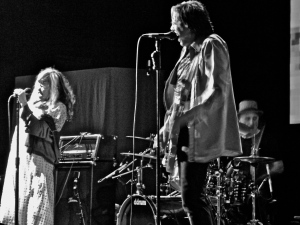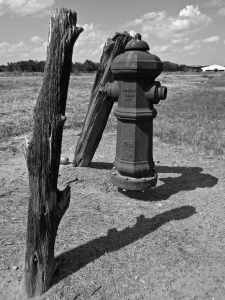First, I am excited to announce that I interviewed John Doe of X last weekend for an hour and a half before a show at Warehouse Live in Houston, TX. The well-rounded, detail-savvy interview will be added to the manuscript for my next book project, Mavericks: Interviews with Indie and Roots Rockers, which is still being evaluated by a college press. Even though cameras were not allowed on the gig floor, I did manage to snap a quick pic of their manic set, which ripped headliner Blondie to shreds.
I have also begun to publish, on-line, my newest folklore project, described below.
For the sake of openness, transparency, and shared knowledge, I have published an ongoing blog about the material culture of POW camps in America during World War II, which will be updated every week for the foreseeable future. Mistakes will be made, so I apologize in advance, and I encourage you to add, expand, fix, or re-shape the text by using either the feedback mechanism on the blog or by emailing me at: leftofthedialmag@hotmail.com. Please used the heading “POW article.”
Abstract in Process: With over 400,000 Axis troops in internment camps throughout most American states and Canada, the region hosted an influx of short-term, temporary, and forced immigrants on an unprecedented scale. Each detention site became a distinct pop-up cultural microcosm – an Italy, Germany, and Japan in exile – that featured both elite high culture activities, like symphonies and romantic drama, and resilient folk art practices as well. Due to overall American tolerance and generosity, in most cases, internees could revel in a sense of pride, nostalgia, and heritage, although overt Nazism was discouraged, undeterred by armed guards and razor wire, which sometimes did not even exist.
Many camp routines did reflect rigid military mores and hierarchies, both Axis and American, but work environments for rank’n’file enlisted men POWs (officers were not required to work), which took place in branch camps situated in rural communities, from rice paddies and East Texas ranches to Midwest orchards and asparagus canning factories, tended to offer more flexibility and freedom, as asserts Nick Clemenza too, a guard stationed in New Mexico “at the Bogle farm, where American soldiers would tell a prisoner needing discipline that he would have to go back to the base camp in Roswell. This worked as discipline because the prisoners preferred the freedom of the Bogle farm.”
These opportunities, which offered kinesic and proximal immersion in workaday American life, fostered amiable perspectives towards former enemies. Such newfound relationships are evidenced in the folk production of goods, from paintings and cabinetry to jewelry, models, and toys, that were handcrafted and gifted, bartered, traded, or sold to locals (the collection of Robert Henderson features a receipt for a POW handicraft valued at $6.00 in 1943, a rare paper trail of evidence), cementing long-lasting relationships and receptive attitudes towards democratic values and systems. Such aspects are chronicled in letters, visitations, and the immigration of former POWs back to America, the country of their detainment.
This blog is dedicated to probing and documenting the lifelong impact of these camps upon prisoners and citizens as well as serve as a means to understand and value the material culture of folk goods that became a mainstay of the informal, shadow economies that shaped camp life.


